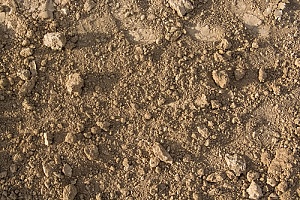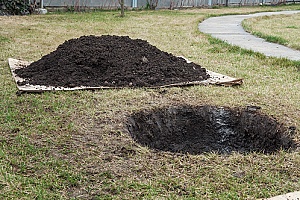 Fill dirt is earth-made material which is used to fill in a depression or hole in the ground or create mounds or otherwise artificially change the grade or elevation of land or construction sites. Fill dirt typically consists of subsoil, which is found about twelve inches below the topsoil. Subsoil itself consists of partially broken down clay, sand, silt, and stones, and any other materials found in the source ground.
Fill dirt is earth-made material which is used to fill in a depression or hole in the ground or create mounds or otherwise artificially change the grade or elevation of land or construction sites. Fill dirt typically consists of subsoil, which is found about twelve inches below the topsoil. Subsoil itself consists of partially broken down clay, sand, silt, and stones, and any other materials found in the source ground.
Fill dirt is stony, heavy, and inorganic. It is these inorganic qualities that make fill dirt desirable for filling holes, as it will not decompose and settle like organic soils are prone to do. Read more about what fill dirt can be used for and find how to determine how much dirt you need to fill a hole.
What Can I Do With Fill Dirt?
While fill dirt is ideal for filling in low areas and holes, it can also be used to:
- Change the elevations on your property
- Support a retaining wall
- Correct poor drainage near your foundation or elsewhere on your property
- Support the construction or demolition of a swimming pool
Different Types of Fill
The type of dirt you need depends on what your project involves. For filling holes, you will want fill dirt — however, the specific type depends on your project. Types of fill dirt include:
Fill Sand
Fill sand, like fill dirt, is used to fill low areas, but fill sand and fill dirt are very different. Fill sand is good for improving drainage around wet areas and to fill areas around septic tanks and ponds where drainage is important. Sand tends to be prone to shifting and displacement, while fill dirt is very stable. As such, fill sand is not good to use as a base for building structures. Fill sand consisting of more than 50% sand is ideal for areas that will be used for plants, and then topped with several inches of topsoil. In short, fill sand is best used in projects that will involve regular exposure to water and moisture.
Rock Fill
 Rock fill, as the name indicates, consists of large rocks. Rock fill is used to fill very deep openings, such as an old swimming pool. The size of the rocks is often larger than a football. You can also use large rocks to landscape your yard. Rock fill is usually obtained from blast sites or deep excavation sites. If you intend to use rock fill in a large hole and cover it with vegetation, you will need to top the rock fill with heavy layers of organic clean topsoil perhaps followed by compost, mulch, or manure.
Rock fill, as the name indicates, consists of large rocks. Rock fill is used to fill very deep openings, such as an old swimming pool. The size of the rocks is often larger than a football. You can also use large rocks to landscape your yard. Rock fill is usually obtained from blast sites or deep excavation sites. If you intend to use rock fill in a large hole and cover it with vegetation, you will need to top the rock fill with heavy layers of organic clean topsoil perhaps followed by compost, mulch, or manure.
Topsoil
Topsoil is not a suitable fill material, but it can be used to fill shallow low spots in your landscape garden or yard where it will support vegetation. Do not use topsoil to fill large holes because topsoil is organic. Also, topsoil will not support the hardscape features of your garden. You will need fill dirt for that purpose. Unlike fill dirt, topsoil will settle and sink as the organic material decays. It contains nutrients that will support grass and plants — therefore, it should only be used for gardens and landscaping plant materials.
How To Determine The Amount Of Dirt Needed To Fill A Hole
Calculating the right amount of dirt may seem challenging. Here are the steps for estimating the amount of fill you will need:
1. Measure the Hole
 Measure the length and width, in feet, of the area where you want to use fill. When you are working on an area that is circular, measure the diameter. For a series of circular shapes, measure the diameter of each one. Your dirt contractor can help you with those measurements.
Measure the length and width, in feet, of the area where you want to use fill. When you are working on an area that is circular, measure the diameter. For a series of circular shapes, measure the diameter of each one. Your dirt contractor can help you with those measurements.
2. Determine the Total Square Footage (Area)
Once you have the length and width measurements, determine the square footage of the surface by multiplying the length times the width. For example, you are filling a hole that is 10 feet long and 4 feet wide, the total square footage is 40 square feet (10′ x 4′).
3. Convert your Square Footage Into Cubic Yards
 Fill dirt is sold in cubic yards. To convert your square footage into cubic yards, you must first divide your square footage by 1,000, and then multiply your result by 3. Your result tells you how many cubic yards will fill one inch of depth.
Fill dirt is sold in cubic yards. To convert your square footage into cubic yards, you must first divide your square footage by 1,000, and then multiply your result by 3. Your result tells you how many cubic yards will fill one inch of depth.
Applying that formula to the example above using 40 square feet, you would need .54 cubic yards:
40 / 1,000 = .04; .04 x 3 = .12 cubic yards
To give you a sense of volume, there are 27 cubic feet in one cubic yard (3′ x 3′ x 3′). A full-size pickup truck holds about 2 cubic yards.
4. Measure the Depth of Your Hole in Inches
If the hole in this example is six feet deep, your hole is 72 inches deep:
6 feet x 12 inches/foot = 72 inches
5. Multiply Your Cubic Yardage By the Inches of Depth
The calculations so far are based on one inch of fill depth. Using our example, the calculation would be:
.12 cubic yards x 72 inches = 8.64 cubic yards of fill
6. Leave a Margin of Error
When your fill area is circular or irregularly shaped, you should add extra cubic yards of fill dirt to ensure you have enough to complete the job. It is a good idea to order an additional ten to fifteen percent of your total cubic yardage. In our example above where we calculated needing 8.64 cubic yards of fill, an additional one cubic yard would likely be a good margin of error. Better yet, consult with your dirt contractor to determine the margin of error.
Speak with the Experts at Dirt Connections For More Information
Before you order your fill dirt, be sure you speak with the professionals at Dirt Connections for more information regarding what kind of dirt you need for your project, calculating the quantity you need, and arranging the delivery. Their expertise can help ensure that your project is a success!








































